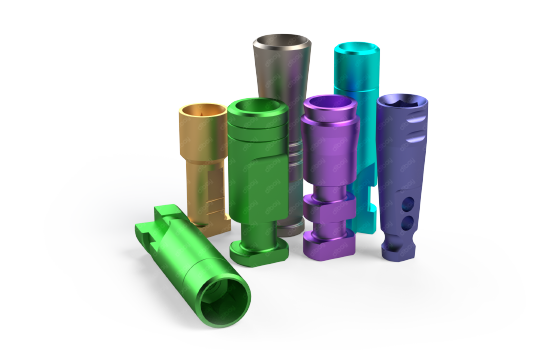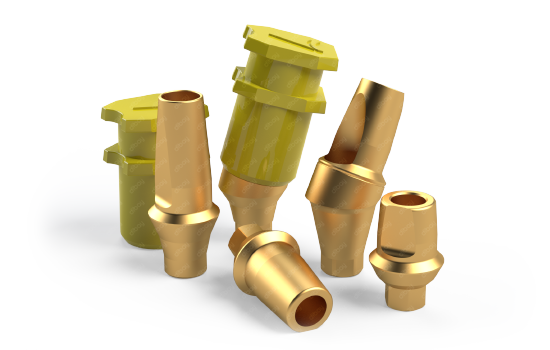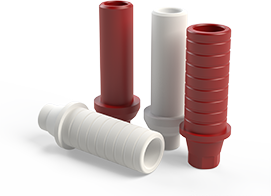Dental Impression Copings and Lab Components in the UAE


Dental Impression Copings and Lab Components in the UAE
- SHOP BY CATEGORY -
Edison Medical Portfolio
Edison Medical's comprehensive portfolio includes impression copings, lab analogs, and castable and UCLA abutments, catering to the diverse needs of dental implantologists, dental technicians, and implantology laboratories. Edison Medical's offerings are designed to meet the demands of every dental professional.
Edison Medical provides lab analogs and impression copings for dental implants, catering to both conventional and digital impression techniques. Importantly, all components from Edison Medical are universally compatible with a wide array of implant brands and systems. This flexibility allows you to seamlessly integrate these components into your existing laboratory setup without the need for alterations, ensuring you won't have to explore alternative solutions or substitutes.
Lab Analogs

Edison Medical’s implant and abutment analogs are suitable for conventional and digital scenarios; all are precision-milled from high-quality titanium and anodized for color coding purposes. The Edison Medical range of dental lab analogs is designed to be compatible with a diverse spectrum of implant systems, including brands like Neo Biotech®, Osstem®, Hiossen®, Astra®, and Megagen®. Furthermore, specifically crafted lab analogs are available for each of Edison Medical’s exclusive Clicq™ systems: Clicq™ Pression (transfer abutments), Pop-Clicq™ (individual abutments), Multi-Clicq™ (multi-unit abutments), and Clicq-Base™ (two-piece Ti-Bases).
Impression Copings

The precision of impression copings plays an important role in the design of restorations, determining the shape, position, and dimensions of the outcome. Edison Medical provides a diverse range of impression copings in various lengths and diameters, along with options for open-tray, closed-tray, and pick-up transfers. This selection empowers you to choose the necessary components, tailoring each restoration with precision to suit the unique prosthetic requirements of individual patients. Straight and angled impression copings are both available for cases requiring angulation correction.
Angled impression copings come with 15° and 25° angulation options, suitable for conventional copings and Edison Medical's innovative Clicq™-Pression line. This system’s impression-transfer acts as both the impression coping and the final abutment.
All impression copings from Edison Medical are precision-milled using premium-quality titanium and treated with titanium nitride (TiN) to create a durable, abrasion-resistant coating. The range includes both closed and open tray impression copings, ensuring the most accurate impressions are achievable.
UCLA and Castable Abutments
Edison Medical's range of castable and UCLA abutments serves as a cost-effective alternative for numerous professionals seeking alternatives to gold UCLA and pre-milled cobalt-chrome abutments. Utilizing injection molding technologies, the burnout products in both standard and UCLA abutments from Edison Medical are crafted to achieve a high-quality surface finish. The base material, polyoxymethylene (POM), ensures that the burnout process leaves no residual debris after melting.
The standard castable abutment from Edison Medical is exclusively composed of POM, while the UCLA abutment lines incorporate a metal base, available in either titanium or cobalt-chrome. This metal base enhances durability and strength, providing a robust solution for dental professionals.
Factors that Affect the Precision of Implant Impressions
Recent research indicates that the precision of implant impressions is affected by various factors, including impression materials, the technique employed, the use of splints on impression posts, the level and depth of the impression, and the orientation of the implants. Studies have highlighted that discrepancies arising from an inaccurate impression, leading to incompatibility between implant components and the prosthesis, may result in issues such as screw loosening, screw fracture, compromised osseointegration, and potentially even implant fracture.
Closed Tray Technique VS Open Tray Technique

The open tray and closed tray techniques serve distinct purposes in transferring the direction, position, or orientation of a dental implant to a working cast or model, each selected based on specific criteria. The open tray technique becomes essential when implants lack the required parallel alignment, posing a challenge for withdrawing an impression from multiple copings. In such cases, temporary copings can be connected using materials like flowable composite, impression plaster, or acrylic resin, enhancing the accuracy of the definitive impression. The custom impression tray is coated with adhesive, and loaded with heavy-body material, and light-body material expressed around the copings to capture the surrounding soft tissue morphology. Alternatively, the monophase impression material is a practical alternative. After polymerization, the screws in temporary copings are loosened for easy removal, resulting in an impression that records edentulous ridges and contains the copings. An alternate approach involves using a modified stock tray for the definitive impression.
On the other hand, the closed tray impression technique is employed when implants exhibit adequate parallel alignment or when faced with limited interarch distance and insufficient space for screw-retained impression copings. This technique utilizes a stock or custom tray, and the closed tray impression coping is placed on implants. Once the impression material polymerizes, the impression is dislodged from the closed tray impression copings. Subsequently, the copings are removed, and implant or abutment analogs are attached before insertion into the definitive impression, providing a comprehensive and tailored approach to dental prosthetics.
What is a Custom Abutment?
Custom abutments are individually crafted by dental labs to match the unique tissue crests of each patient. They provide a precise aesthetic match.
What are Dental Lab Components?
Dental lab components are various elements essential for the construction of the dental prosthesis within a dental laboratory. These components encompass single- and multi-unit analogs and transfers, abutments, cast crowns, retainers, fixed and removable prosthetics, impression posts, scan bodies, the healing abutment, and other related materials.











